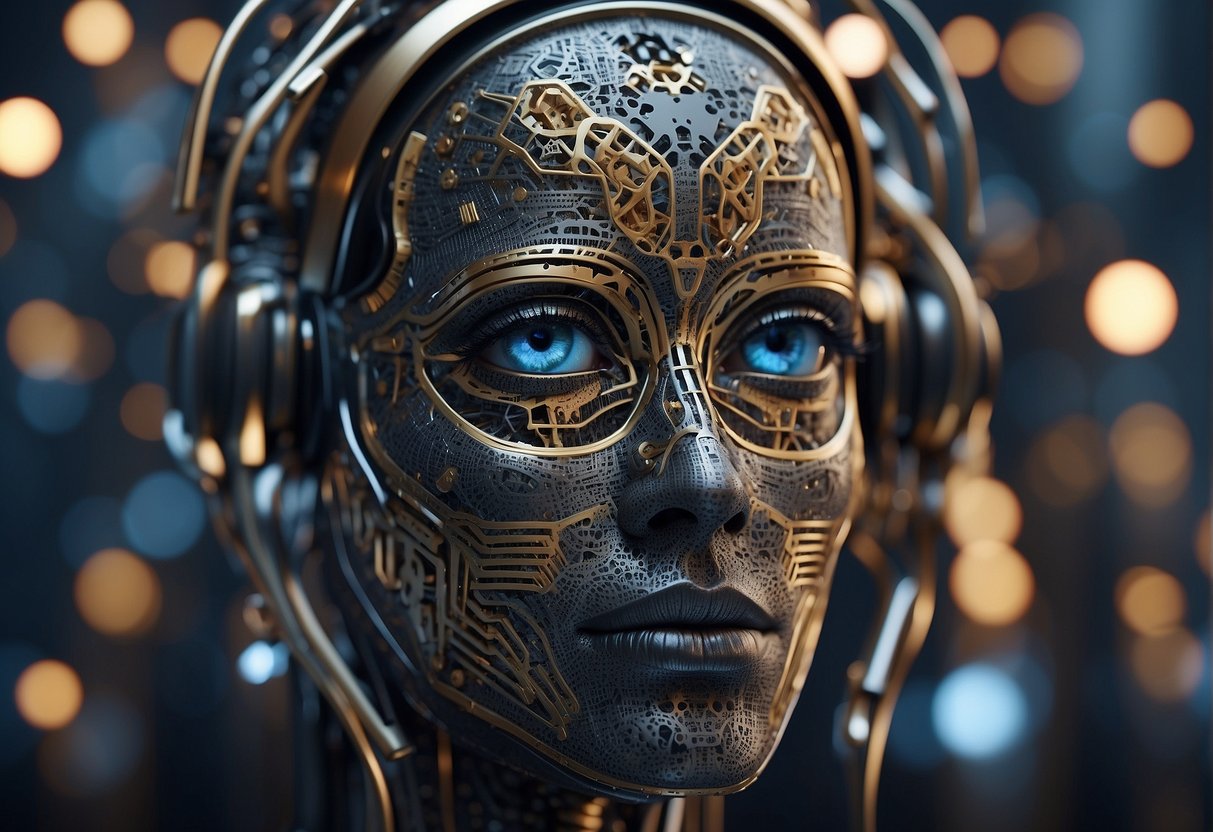Generative artificial intelligence represents a shift in the capabilities of AI technologies, as it can produce novel content like text, images, audio, and more. Unlike traditional AI which focuses on analysis and pattern recognition, generative AI has the ability to understand and mimic the structure of the input it is trained on to create new, previously non-existing pieces that appear convincingly realistic.

The development and use of these systems are made possible by advanced machine learning models, particularly those known as generative adversarial networks (GANs) and variational autoencoders (VAEs). For instance, these models can hallucinate faces of people that do not exist or compose music that no human has ever written. Because of this, the applications of generative AI are numerous, ranging from entertainment and art to more practical uses like prototyping and data augmentation.
As a cornerstone of innovative AI research, generative AI has garnered substantial attention across various industries due to its potential to automate creativity and design. Where discerning humans might struggle to differentiate between machine-generated and human-made work, generative AI models are proving themselves as powerful tools for creating high-quality, diverse, and scalable outputs, thus pushing the boundaries of what machines can create.
Fundamentals of Generative AI

In exploring the essentials of Generative AI, it is crucial to understand its definition, key concepts, and historical development to grasp its capabilities and evolution.
Defining Generative AI
Generative AI refers to the category of artificial intelligence that is capable of generating new content, from images to text to music, by learning from a given dataset. These AI models, such as OpenAI’s applications, can produce original output that mimics the data they were trained on.
Key Concepts
Large Language Models (LLMs): At the core of Generative AI, LLMs are trained on extensive text corpora and can generate coherent and contextually relevant text-based responses.
Neural Networks: These are computational models inspired by the human brain that can learn patterns in data and are fundamental to developing Generative AI systems.
- Training: The process involves feeding large datasets to the AI and adjusting the model’s parameters to minimize errors in its output.
- Overfitting and Underfitting: Critical issues referring to a model that learns the training data too well and fails to generalize, or one that doesn’t learn the data well enough.
Historical Development
The evolution of Generative AI began with simpler models and has progressed to sophisticated systems like BERT and GPT. Initially, these models used limited datasets and simpler algorithms, but the advent of larger datasets and more complex neural network designs have vastly improved their generative capabilities.
Technologies Behind Generative AI

Generative AI is driven by cutting-edge technology designed to emulate human creativity and generate new content. These systems leverage complex algorithms and data processing techniques to push the boundaries of what machines can do.
Machine Learning
Machine learning is at the core of generative AI. It involves training algorithms on a dataset to enable them to make informed decisions or predictions. Generative models, such as Generative Adversarial Networks (GANs) or Variational Autoencoders (VAEs), are machine learning systems that have been particularly influential in this field. These models learn to produce new data that resembles their training data.
Deep Learning
Deep learning is a specialized subset of machine learning that structures algorithms in layers to create an “artificial neural network” that can learn and make intelligent decisions on its own. Deep learning drives the ability of generative AI to create highly realistic outputs by processing vast amounts of data. Systems utilizing deep learning can generate novel content including images, videos, and music.
Neural Networks
Neural networks, specifically deep neural networks, are vital for the function of generative AI. They consist of interconnected nodes or “neurons” that process information in a way analogous to the human brain. The layers within neural networks can identify patterns and features in the data, which are essential for the generation of new, complex outputs.
Natural Language Processing
Natural Language Processing (NLP) enables computers to understand, interpret, and generate human language. In the context of generative AI, NLP is used to create text that is coherent, contextually relevant, and often indistinguishable from text written by humans. NLP technologies harness models like GPT-3 to produce everything from poetry to code, expanding the reach of generative systems into the linguistic domain.
Applications of Generative AI

Generative AI is reshaping industries and revolutionizing the way tasks are approached. It showcases a variety of applications, from creating new content to accelerating innovation in scientific fields.
Content Creation
Generative AI can produce novel text, images, graphics, and other forms of content, often in response to specific prompts. For example, transforming text into images or generating marketing materials tailored to a brand’s aesthetic and message with impressive speed and accuracy.
Media and Entertainment
In the realm of media and entertainment, generative AI is used to create digital art, music, and videos, opening new frontiers in how content is developed and personalized. It can alter the visual effects in movies or generate immersive virtual reality environments, providing more engaging user experiences.
Science and Research
Generative models like GANs and transformer-based models have become instrumental in scientific advancements, assisting in tasks such as drug discovery, simulating molecular structures, and predicting chemical reactions, thereby reducing the time and cost associated with traditional experimental methods.
Healthcare
The healthcare sector benefits from generative AI by enhancing personalized medicine and aiding in the analysis of medical images. It can generate synthetic data for training algorithms while adhering to privacy considerations, and support the design of new drugs and treatment plans with its predictive capabilities.
Development of Generative AI Models

The development of Generative AI models is a complex, multi-stage process that includes meticulous data handling, rigorous training methodologies, precise evaluation, and continuous improvement strategies.
Data Collection and Processing
The initial phase in the development of Generative AI models involves the collection and processing of large datasets. These datasets must be diverse and of high quality to train models effectively. They undergo preprocessing, which includes cleaning, normalization, and augmentation, to ensure that the data is conducive to training robust models.
Model Training
Model training is the core phase where the processed data is used to teach the algorithm to generate new content. Complex neural networks, particularly Generative Adversarial Networks (GANs) and Variational Autoencoders (VAEs) are common architectures used. They learn by going through vast amounts of data, and repeatedly adjusting internal parameters to reduce the difference between the generated outputs and the real-world data they mimic.
Evaluation Metrics
After training, models are assessed using evaluation metrics to gauge their performance. Common metrics include Perplexity, Bleu Score, and Frechet Inception Distance (FID) for images. These metrics help developers understand a model’s proficiency in generating coherent and contextually relevant outputs.
Fine-Tuning and Optimization
Generative AI models often require fine-tuning and optimization post-initial training. Techniques such as hyperparameter tuning, transfer learning, and feature engineering are employed to refine the models. This process improves model performance and ensures its outputs meet the desired standards of quality and uniqueness.
Challenges in Generative AI

Generative AI, while innovative, faces several hurdles that can affect its development and application. These challenges range from ethical dilemmas to technical constraints.
Ethical Considerations
Generative AI systems can create content that is indistinguishable from that produced by humans, leading to concerns about misinformation and the potential for deception. There is also a growing discourse on the impact these technologies have on creative industries and intellectual property rights.
Bias and Fairness
Bias can be encoded inadvertently in AI models, often reflecting the biases present in their training data. The consequences are not trivial, as they can propagate and amplify societal biases, influencing decision-making in critical sectors such as law enforcement and hiring.
Computational Costs
Generative AI models require substantial computational power, translating to high energy consumption and associated costs. This demand can limit the accessibility of generative AI tools, reserving their use for organizations with significant resources.
Data Privacy
The training of generative AI models typically involves large volumes of data which can include sensitive information. Protecting this data and ensuring it is not misused is a pressing concern for regulators and developers alike, especially with the advent of more stringent data privacy laws.
Future Directions of Generative AI

The evolution of generative AI heralds transformative shifts across sectors. In its trajectory, pivotal areas such as accessibility, architectural innovation, inter-disciplinary use cases, and regulatory frameworks stand out.
Improving Accessibility
Efforts are underway to make generative AI more user-friendly and widely accessible. Companies are focusing on creating intuitive platforms that allow users with varied levels of expertise to harness the power of AI for content creation, data analysis, and problem-solving.
Advances in Model Architectures
The next wave involves enhancements in model architectures, forging paths to efficiency and scalability. Recent studies hint at the possibility of more sophisticated models that can generate increasingly accurate results with less computational overhead.
Cross-Disciplinary Applications
Generative AI is set to break barriers, facilitating cross-disciplinary collaborations that innovate solutions transcending traditional domain boundaries. Key stakeholders foresee applications ranging from drug discovery to architectural design, where the AI’s generative capabilities can provide unprecedented value.
Policy and Regulation
As AI’s impact grows, so does the need for comprehensive policy and regulation. Thought leaders are advocating for frameworks that balance innovation with ethics, privacy, and security, ensuring the responsible deployment of AI technologies.
Frequently Asked Questions

Generative AI is reshaping various sectors with its ability to create original content and solve complex problems. Here are some specific questions that can give you a clearer grasp of its capabilities and applications.
What are some common uses of generative AI across different industries?
Generative AI applications range from creating realistic images and composing music to generating written content and developing new drug formulations. Industries from entertainment to pharmaceuticals are leveraging these capabilities to innovate and enhance productivity.
Which platforms offer the best tools for implementing generative AI?
Platforms such as OpenAI provide advanced tools for implementing generative AI, including the highly popular GPT models for natural language processing. Additionally, solutions like Google’s DeepMind and AI offerings from IBM are also significant contributors to the ecosystem.
How is generative AI being utilized in the healthcare sector?
In healthcare, generative AI is used for drug discovery by predicting molecular reactions and for personalized medicine, creating tailored treatment plans. It also supports medical diagnostics by generating accurate models to assist in interpreting medical imagery.
Can you provide examples of generative AI in action?
Examples include AI-generated artwork, predictive text applications that draft emails, and AI-assisted music composition tools. These applications showcase generative AI’s ability to enhance creative processes and reduce repetitive tasks.
What distinguishes generative AI from traditional AI technologies?
Generative AI is characterized by its ability to produce new and diverse content, as opposed to traditional AI which typically focuses on recognition or classification tasks. This generativity marks a significant leap in AI’s evolution from observational to creative.
How does OpenAI’s technology relate to the broader field of generative AI?
OpenAI has been at the forefront, with its technology widely recognized for setting benchmarks in the field. Contributions like ChatGPT have not only shown the potential of language models but also sparked wider interest and development in generative AI technologies.